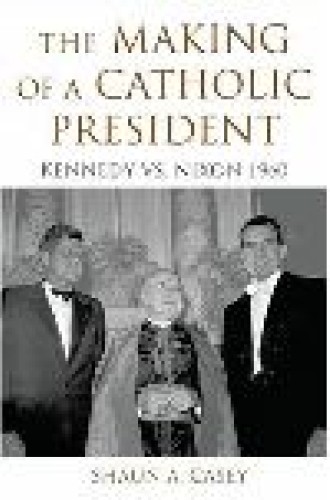The Making of a Catholic President: Kennedy vs. Nixon 1960
Books on the 1960 presidential campaign inevitably invite comparison with journalist Theodore White’s best-selling The Making of the President, 1960. The book’s success derived in part from the public’s fascination with the televised presidential debates. Kennedy’s youth and charisma also whetted the popular appetite for information about his strategy and political maneuvering.
In The Making of a Catholic Presi dent, Shaun Casey uses a similar title, but he presents no preface, introduction, road map or explanation of the book’s goals. In seven chronologically organized chapters, he presents a blow-by-blow account of the actions of the individuals and groups who responded most actively to the prospect of a Catholic in the White House. Having served as an adviser to Barack Obama during the 2008 campaign, Casey is in a good position to provide some pointers about religion’s proper role in presidential politics. Yet readers need to wait for the epilogue before they encounter any semblance of an overarching thesis.
Casey’s epilogue would have served as a useful introduction because it provides some organizing structure for the book’s compelling and often original details. For example, Casey draws two conclusions that are helpful for politicians. First, candidates should actively engage the opposition. Kennedy pursued Protestant elites in an effort to understand the roots of their doubts about a Catholic president. Second, political parties should avoid “clandestine organizing” of religious groups. Casey tells how one Republican operative united many liberal and conservative Protestants in a secret campaign to defeat Kennedy by inciting fears of Catholic power.
These two lessons are very debatable. To demonstrate the first point—that candidates benefit from pursuing dialogue with critics—Casey highlights Kennedy’s personal meeting with Methodist bishop G. Bromley Oxnam, whom Casey describes as “the closest thing to an American Protestant cardinal in the middle of the twentieth century.” As Casey’s research reveals, Oxnam recorded how impressed he was by Kennedy’s “extraordinary charm.” As the campaign commenced, however, the bishop was still outspoken in criticism of Kennedy and the Catholic Church. One can speculate that Kennedy’s charm offensive may have blunted Oxnam’s sword (and Casey may have witnessed, and even encouraged, this strategy in 2008 with Barack Obama’s outreach to conservative evangelicals), but there is no way to prove that it did.
It is also easy to quibble with the evidence supporting Casey’s second lesson, that it is dangerous for campaigns to work secretly with religious groups. With detective-like research, Casey uncovered the covert operations of Orland K. Armstrong, Republican National Com mittee employee and former member of Congress from Spring field, Missouri. Exploiting connections with liberal and conservative Prot estants from multiple denominations, Arm strong fostered anti-Catholic doubts about Kennedy’s candidacy. After encouraging the Southern Baptist Convention to pass a resolution expressing grave reservations about the election of a Catholic president, he carried his message to 48 conferences in 12 states. Although Casey implies that Nixon knew about Armstrong’s efforts—and given Nixon’s role in Watergate, one might assume that he participated in this anti-Catholic campaign—Casey’s impressive investigations reveal no evidence that Nixon or the RNC guided Arm strong’s actions.
Casey’s archival discoveries will be valuable for scholars. For example, he suggests that one Protestant minister, W. Stanley Rycroft, played an important role in undermining the Protestant cabal against Kennedy. As a board member of Protestants and Other Americans United for Separation of Church and State (POAU), Rycroft likely leaked the organization’s plans to mobilize national opposition to a Kennedy. Citing documents in the Kennedy library referring to “Informant R,” Casey chronicles what are probably Rycroft’s objections to POAU’s explicitly anti-Kennedy strategy in the campaign. He also interviewed a reporter who undermined Protestant ministers’ efforts to disguise their unequivocal anti-Catholic attitudes. When Norman Vincent Peale and other nationally known clergy met behind closed doors in Washington’s May flower Hotel in September 1960, the reporter hid in a sound room with a colleague to listen secretly to the proceedings. As a result, they could contradict Peale’s claim that the meeting was not explicitly directed against Kennedy’s Cath olicism.
The real lesson of the 1960 campaign is that many Protestant organizations soon had reason to regret the role they played. By pressuring Kennedy to disavow his religious roots, Christian institutions encouraged the marginalization of religion from public life. As Casey recounts, many Protestants—including several who wrote articles in the Christian Century—proved unrelenting in raising doubts about a Catholic president’s independence from clerical authority. By overemphasizing the value of individual liberty, these writers undermined the power of Christian conscience in supporting moral reform. On the other end of the political spectrum, the National Association of Evangelicals has since abandoned fears of Catholic power and has pursued alliances with the Catholic Church in support of faith-based social service initiatives and in opposition to abortion and same-sex marriage.
Shaun Casey’s investigative research has provided a useful complement to the work of Theodore White, who knew little about the elite and grassroots anti-Catholicism that Casey chronicles. But in today’s climate of obsession with economic affairs, will Americans pause to reflect on the 1960 election’s legacy of hyperindividualism and secularism?






